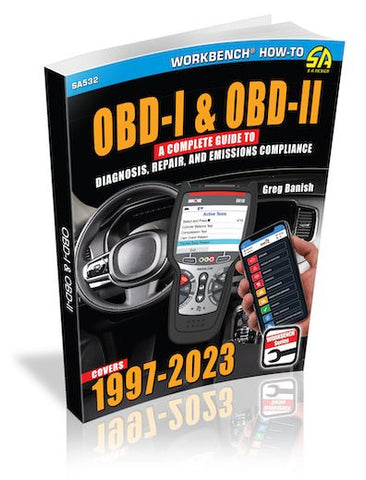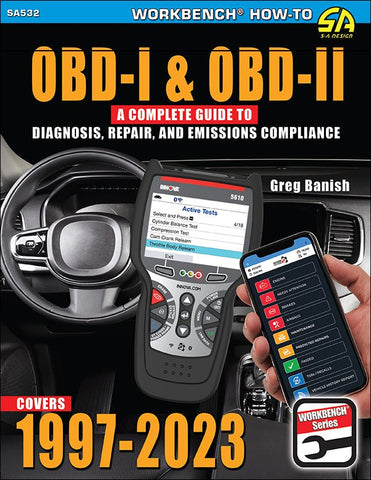OBD-I & OBD-II: A Complete Guide to Diagnosis, Repair, & Emissions Compliance is an insider’s guide to modern original equipment manufacturer (OEM) diagnostics systems. As a former diagnostics and performance calibration engineer, Greg Banish guides you through critical electronic control unit (ECU) functions that ultimately lead to why the "check engine" light on the dash is lit. Strategies are provided for how to begin looking for a solution when problems are detected. Listing every imaginable repair is impossible, but this book provides a solid foundation from which to work by explaining the electronic control unit ECU's logic in plain English. Practical examples from the author’s experience highlight important lessons that will save hours of frustration and confusion. In addition to repair tips, sound advice is given for those looking to modify their vehicles while maintaining the full functionality of the emissions and diagnostics systems.
Modern diagnostics systems can be a blessing or a curse, depending on your level of understanding. This book helps you harness the power of the diagnostics inside the ECU to improve the ability to find and make the right repair the first time. This book shows that by using commonly available electronic tools, the consumer has the power to access a wealth of information about his or her vehicle. It also helps those who are looking to improve performance do so without compromise to the environment or enforcement agencies. Whether you want to repair the vehicle yourself or simply want to possess an understanding of how these systems work while dealing with service professionals, this is the guide you need.
Preface
Introduction
Chapter 1: Background and Origins
Emissions
Defeat Devices
Notable Defeat Infractions
What Is OBD-III?
ADAS
Chapter 2: Uses of OBD
Mode $01
Mode $02
Mode $03
Mode $04
Mode $05
Mode $06
Mode $07
Mode $08
Mode $09
Mode $0A
Emissions and MIL Connection
State Inspections
Manufacturer Audit/Tracking
A Useful Access Point
Chapter 3: CAN and Other Networks
SAE J2534 and ISO 15765 CAN
CAN Flexible Data
Chapter 4: Basic Engine Controls
Airflow Models
Fuel Delivery
Transient Air-Fuel Control
Spark Delivery
Torque Control
Additional Features
Chapter 5: Fault Code Fundamentals
Single or Multiple Failures
Decoding the Codes
Clearing Codes
Chapter 6: Generic SAE Fault Codes
Input Sensors
Input Sensor Faults: Common Causes and Repairs
Output Circuits
Output-Circuit Faults: Common Causes and Repairs
Catalyst Group
Catalyst Group Faults: Common Causes and Repairs
Evaporative System
Evaporative Group Faults: Common Causes and Repairs
Chapter 7: Manufacturer-Specific Diagnostic Codes
P1XXX Range
Chapter 8: OBD Monitors
Misfire Monitor
Ignition Failures
Fuel System Failures
Airflow Failures
Fuel System Monitor
Comprehensive Components Monitor
Oxygen Sensor Monitor
Oxygen Sensor Heater Monitor
Catalyst Monitor
Heated Catalyst Monitor
Evaporative System Monitor
Secondary Air System Monitor
EGR/VVT Monitor
Diesel-Specific Monitors
NMHC Catalyst and PM Filter Monitors
NOx/SCR Aftertreatment
Boost Pressure
Chapter 9: Use of OBD in Vehicle Inspection and Monitoring
What Do They Look At?
Pass versus Fail
Correcting a Failed Test
Chapter 10: OBD-Based Tools
Basic Code Readers
Dealer-Level Tools
Independent Tools
Aftermarket Tuning Tools
Data Logging
Chapter 11: Using OBD to Diagnose When an MIL Isn’t Present
Tools for Advanced Diagnostics
Misfires
Fuel Contamination
Low Fuel Pressure
No Start, Hard Start
Poor Performance and Economy
Vacuum and Boost Leaks
Chapter 12: Special Notes for Tuners
Piggyback Systems
Replacement ECUs
Adjusting the Factory ECU
Linking OBD and Emissions
Creating a Clean Tailpipe Measurement
Catalyst Lightoff
Minimizing Emissions After Warmup
Oxides of Nitrogen
Final Cleanup and Spotting the Problems
Passing OBD Monitors
Notes for Smaller Shops
Chapter 13: Conclusion
Appendix: Fault Diagnostic Examples
Unplugged MAF Sensor
Aging Oxygen Sensor
Coil Fault
Glossary
OBD-I & OBD-II: A Complete Guide to Diagnosis, Repair, & Emissions Compliance is an insider’s guide to modern original equipment manufacturer (OEM) diagnostics systems. As a former diagnostics and performance calibration engineer, Greg Banish guides you through critical electronic control unit (ECU) functions that ultimately lead to why the "check engine" light on the dash is lit. Strategies are provided for how to begin looking for a solution when problems are detected. Listing every imaginable repair is impossible, but this book provides a solid foundation from which to work by explaining the electronic control unit ECU's logic in plain English. Practical examples from the author’s experience highlight important lessons that will save hours of frustration and confusion. In addition to repair tips, sound advice is given for those looking to modify their vehicles while maintaining the full functionality of the emissions and diagnostics systems.
Modern diagnostics systems can be a blessing or a curse, depending on your level of understanding. This book helps you harness the power of the diagnostics inside the ECU to improve the ability to find and make the right repair the first time. This book shows that by using commonly available electronic tools, the consumer has the power to access a wealth of information about his or her vehicle. It also helps those who are looking to improve performance do so without compromise to the environment or enforcement agencies. Whether you want to repair the vehicle yourself or simply want to possess an understanding of how these systems work while dealing with service professionals, this is the guide you need.
Preface
Introduction
Chapter 1: Background and Origins
Emissions
Defeat Devices
Notable Defeat Infractions
What Is OBD-III?
ADAS
Chapter 2: Uses of OBD
Mode $01
Mode $02
Mode $03
Mode $04
Mode $05
Mode $06
Mode $07
Mode $08
Mode $09
Mode $0A
Emissions and MIL Connection
State Inspections
Manufacturer Audit/Tracking
A Useful Access Point
Chapter 3: CAN and Other Networks
SAE J2534 and ISO 15765 CAN
CAN Flexible Data
Chapter 4: Basic Engine Controls
Airflow Models
Fuel Delivery
Transient Air-Fuel Control
Spark Delivery
Torque Control
Additional Features
Chapter 5: Fault Code Fundamentals
Single or Multiple Failures
Decoding the Codes
Clearing Codes
Chapter 6: Generic SAE Fault Codes
Input Sensors
Input Sensor Faults: Common Causes and Repairs
Output Circuits
Output-Circuit Faults: Common Causes and Repairs
Catalyst Group
Catalyst Group Faults: Common Causes and Repairs
Evaporative System
Evaporative Group Faults: Common Causes and Repairs
Chapter 7: Manufacturer-Specific Diagnostic Codes
P1XXX Range
Chapter 8: OBD Monitors
Misfire Monitor
Ignition Failures
Fuel System Failures
Airflow Failures
Fuel System Monitor
Comprehensive Components Monitor
Oxygen Sensor Monitor
Oxygen Sensor Heater Monitor
Catalyst Monitor
Heated Catalyst Monitor
Evaporative System Monitor
Secondary Air System Monitor
EGR/VVT Monitor
Diesel-Specific Monitors
NMHC Catalyst and PM Filter Monitors
NOx/SCR Aftertreatment
Boost Pressure
Chapter 9: Use of OBD in Vehicle Inspection and Monitoring
What Do They Look At?
Pass versus Fail
Correcting a Failed Test
Chapter 10: OBD-Based Tools
Basic Code Readers
Dealer-Level Tools
Independent Tools
Aftermarket Tuning Tools
Data Logging
Chapter 11: Using OBD to Diagnose When an MIL Isn’t Present
Tools for Advanced Diagnostics
Misfires
Fuel Contamination
Low Fuel Pressure
No Start, Hard Start
Poor Performance and Economy
Vacuum and Boost Leaks
Chapter 12: Special Notes for Tuners
Piggyback Systems
Replacement ECUs
Adjusting the Factory ECU
Linking OBD and Emissions
Creating a Clean Tailpipe Measurement
Catalyst Lightoff
Minimizing Emissions After Warmup
Oxides of Nitrogen
Final Cleanup and Spotting the Problems
Passing OBD Monitors
Notes for Smaller Shops
Chapter 13: Conclusion
Appendix: Fault Diagnostic Examples
Unplugged MAF Sensor
Aging Oxygen Sensor
Coil Fault
Glossary










